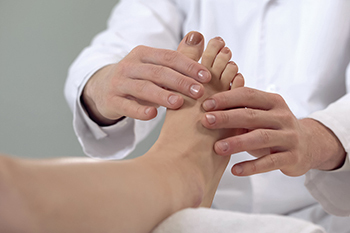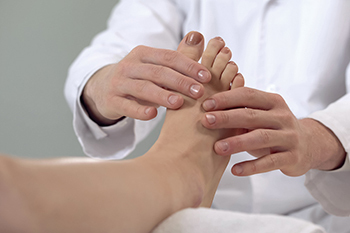Connect With Us
Blog
Items filtered by date: September 2022
Metatarsal Stress Fractures

The foot is made up of tiny bones, called metatarsals. A metatarsal stress fracture is an acute fracture of one of these little bones. This usually occurs from overuse or poor foot mechanics. When bodies break down, they generally break down at the weakest point. In sports, stress fractures are caused by repetitive force over a long period of time. Metatarsal fractures can happen from wearing the wrong shoes, training on hard pavement and poor nutrition. These factors puts one at higher risk for developing stress fractures. Symptoms of metatarsal stress fractures are dull, underlying pain, that can be intermittent. One should not ignore pain of any sort. In fact, catching and treating pain early can help metatarsal stress fractures heal quicker than if ignored. If you feel you have sustained a stress fracture or have any other pain in your feet, it is suggested that you consult with a podiatrist who can diagnose the problem and get you back to full functioning as soon as possible.
Activities where too much pressure is put on the feet can cause stress fractures. To learn more, contact Imaze Marian Davis, DPM from Marian Davis, DPM, PA. Our doctors can provide the care you need to keep your pain free and on your feet.
Dealing with Stress Fractures of the Foot and Ankle
Stress fractures occur in the foot and ankle when muscles in these areas weaken from too much or too little use. The feet and ankles then lose support when walking or running from the impact of the ground. Since there is no protection, the bones receive the full impact of each step. Stress on the feet can cause cracks to form in the bones, thus creating stress fractures.
What Are Stress Fractures?
Stress fractures occur frequently in individuals whose daily activities cause great impact on the feet and ankles. Stress factors are most common among:
- Runners
- People affected with Osteoporosis
- Tennis or basketball players
- Gymnasts
- High impact workouts
Symptoms
Pain from the fractures occur in the area of the fractures and can be constant or intermittent. It will often cause sharp or dull pain with swelling and tenderness. Engaging in any kind of activity which involves high impact will aggravate pain.
If you have any questions please feel free to contact our office located in Miami, FL . We offer the newest diagnostic and treatment technologies for all your foot and ankle needs.
What Can Cause Tarsal Tunnel Syndrome?

There is a nerve that stretches from the back of the leg to the inner ankle, and this is known as the tibial nerve. When this becomes pinched as a result of an injury, it may lead to tarsal tunnel syndrome. Additionally, this condition may occur in people who have flat feet or who have an existing tissue mass or cyst. It is helpful to rest the affected foot as often as possible as this may reduce some of the associated swelling. In severe cases, anti-inflammatory medications may be prescribed, and it can be beneficial to wear custom-made orthotics. Numbness and a tingling sensation are symptoms that people can experience when they have this condition, and it can be quite uncomfortable. If you are afflicted with tarsal tunnel syndrome, it is strongly urged that you consult with a podiatrist who can effectively determine the cause, as well as implement the correct treatment methods.
Tarsal tunnel syndrome can be very uncomfortable to live with. If you are experiencing tarsal tunnel syndrome, contact Imaze Marian Davis, DPM of Marian Davis, DPM, PA. Our doctors can provide the care you need to keep you pain-free and on your feet.
Tarsal Tunnel Syndrome
Tarsal tunnel syndrome, which can also be called tibial nerve dysfunction, is an uncommon condition of misfiring peripheral nerves in the foot. The tibial nerve is the peripheral nerve in the leg responsible for sensation and movement of the foot and calf muscles. In tarsal tunnel syndrome, the tibial nerve is damaged, causing problems with movement and feeling in the foot of the affected leg.
Common Cause of Tarsal Tunnel Syndrome
- Involves pressure or an injury, direct pressure on the tibial nerve for an extended period of time, sometimes caused by other body structures close by or near the knee.
- Diseases that damage nerves, including diabetes, may cause tarsal tunnel syndrome.
- At times, tarsal tunnel syndrome can appear without an obvious cause in some cases.
The Effects of Tarsal Tunnel Syndrome
- Different sensations, an afflicted person may experience pain, tingling, burning or other unusual sensations in the foot of the affected leg.
- The foot muscles, toes and ankle become weaker, and curling your toes or flexing your foot can become difficult.
- If condition worsens, infections and ulcers may develop on the foot that is experiencing the syndrome.
A physical exam of the leg can help identify the presence of tarsal tunnel syndrome. Medical tests, such as a nerve biopsy, are also used to diagnose the condition. Patients may receive physical therapy and prescriptive medication. In extreme cases, some may require surgery.
If you have any questions please feel free to contact our office located in Miami, FL . We offer the newest diagnostic and treatment technologies for all your foot and ankle needs.
Types of Foot Ulcers

Research has indicated there are millions of Americans that live with chronic wounds and some may produce foot pain. A common foot wound is a diabetic foot ulcer which often results from diabetes and neuropathy. They generally develop on the sole of the foot or on the big toe. Additional types of wounds on the feet include a venous stasis ulcer which is caused by damaged veins. If there is arterial insufficiency, an arterial ulcer may develop and can be found on the tips of the toes or between them. When improper shoes are worn or there is a lack of movement, a pressure ulcer can form in the heel or ankle. There are several methods that can help prevent wounds on the feet like refraining from walking barefoot, washing and drying the feet daily, and moisturizing the soles of the feet when they are damp. It is also beneficial to prevent the feet from being extremely hot or cold. It is important to examine the feet every day for existing cuts, bruises, and scrapes. If you would like more information about foot ulcers and how to prevent them, please confer with a podiatrist who can address any concerns you may have.
Foot Pain
Foot pain can be extremely painful and debilitating. If you have a foot pain, consult with Imaze Marian Davis, DPM from Marian Davis, DPM, PA. Our doctors will assess your condition and provide you with quality foot and ankle treatment.
Causes
Foot pain is a very broad condition that could be caused by one or more ailments. The most common include:
- Bunions
- Hammertoes
- Plantar Fasciitis
- Bone Spurs
- Corns
- Tarsal Tunnel Syndrome
- Ingrown Toenails
- Arthritis (such as Gout, Rheumatoid, and Osteoarthritis)
- Flat Feet
- Injury (from stress fractures, broken toe, foot, ankle, Achilles tendon ruptures, and sprains)
- And more
Diagnosis
To figure out the cause of foot pain, podiatrists utilize several different methods. This can range from simple visual inspections and sensation tests to X-rays and MRI scans. Prior medical history, family medical history, and any recent physical traumatic events will all be taken into consideration for a proper diagnosis.
Treatment
Treatment depends upon the cause of the foot pain. Whether it is resting, staying off the foot, or having surgery; podiatrists have a number of treatment options available for foot pain.
If you have any questions, please feel free to contact our office located in Miami, FL . We offer the newest diagnostic and treatment technologies for all your foot care needs.
Understanding the Causes and Treatments of Hammertoes

When muscles, ligaments, or tendons in the feet become imbalanced from improper footwear, genetic foot conditions, diabetes, or neurological damage, a hammertoe may develop. This is a contracture deformity of joint(s) in a toe, causing it to become bent or curled, rather than laying flat and pointing forward. Hammertoes are a progressive disorder. At first, they are flexible (moveable), but may become rigid (fixed) if left untreated. Aside from being unattractive, hammertoes can cause corns and calluses to develop, as the bent toe can rub repeatedly against footwear. Hammertoes can also lead to other, more serious, complications such as bunions, arthritis pain, and metatarsalgia. Treating a hammertoe in its early stages is important, before it becomes rigid and may require surgery. Contact a podiatrist as soon as you notice that your toe seems stuck in a bent position. Depending on the severity, pain, and cause of your hammertoe, your podiatrist may be able to treat it conservatively with orthotics and a change in footwear, specific exercises, nonsteroidal anti-inflammatory medications, cortisone injections and more.
Hammertoe
Hammertoes can be a painful condition to live with. For more information, contact Imaze Marian Davis, DPM from Marian Davis, DPM, PA. Our doctors will answer any of your foot- and ankle-related questions.
Hammertoe is a foot deformity that affects the joints of the second, third, fourth, or fifth toes of your feet. It is a painful foot condition in which these toes curl and arch up, which can often lead to pain when wearing footwear.
Symptoms
- Pain in the affected toes
- Development of corns or calluses due to friction
- Inflammation
- Redness
- Contracture of the toes
Causes
Genetics – People who are genetically predisposed to hammertoe are often more susceptible
Arthritis – Because arthritis affects the joints in your toes, further deformities stemming from arthritis can occur
Trauma – Direct trauma to the toes could potentially lead to hammertoe
Ill-fitting shoes – Undue pressure on the front of the toes from ill-fitting shoes can potentially lead to the development of hammertoe
Treatment
Orthotics – Custom made inserts can be used to help relieve pressure placed on the toes and therefore relieve some of the pain associated with it
Medications – Oral medications such as anti-inflammatories or NSAIDs could be used to treat the pain and inflammation hammertoes causes. Injections of corticosteroids are also sometimes used
Surgery – In more severe cases where the hammertoes have become more rigid, foot surgery is a potential option
If you have any questions please contact our office located in Miami, FL . We offer the newest diagnostic and treatment technologies for all your foot and ankle needs.


